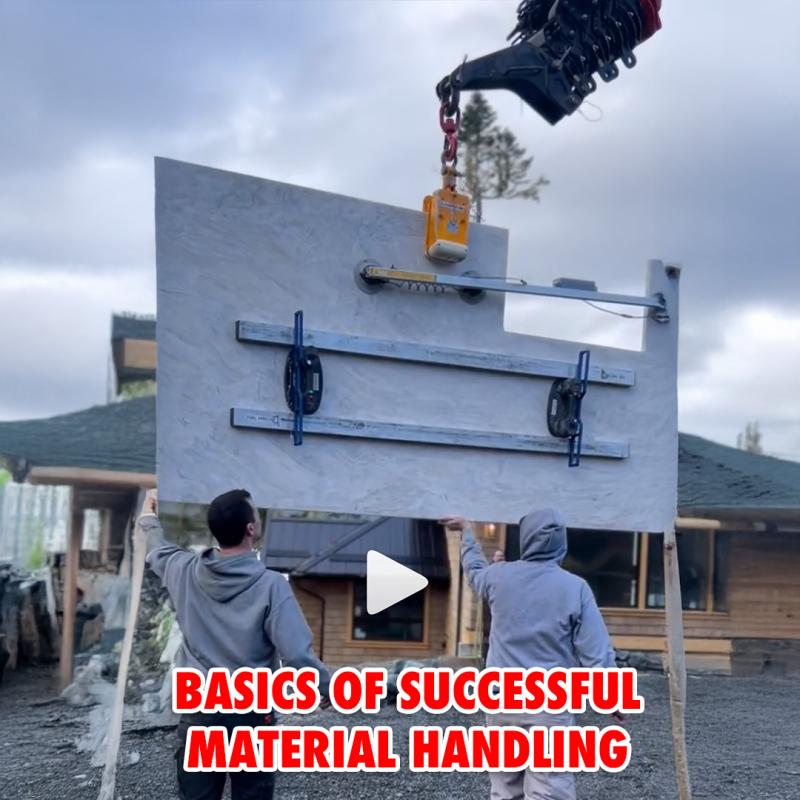



Organizations must optimize processes and carefully select their material handling equipment to maintain competitiveness, safety, and quality. This guide covers the fundamental concepts, equipment categories, core principles, and strategic considerations needed to build a successful material handling operation.
Effective material handling encompasses the movement, protection, storage, and control of materials throughout every stage of production and distribution. Proper handling not only ensures timely order fulfillment and customer satisfaction but also enhances workplace safety, minimizes product damage, and drives operational efficiency across sectors—from automotive and aerospace to food & beverage, pharmaceuticals, and construction.
Vertical movement demands specialized lifting solutions that combine strength with precision:
The right slab lifter for secure granite and stone handling
Scissor carry clamps designed to grip and transport fragile panels
Stone lifting clamp engineered for horizontal slab manipulation
Glass lifter for precise glass panel installation
Electric Powered Vacuum Glass Lifter combining suction power with mobility
Forklift boom attachments to extend reach capability
Block lifting clamps that boost productivity in stone processing
Ratchet straps are fasteners and general-purpose ratchet tie down traps
These devices reduce manual strain, improve ergonomics, and minimize damage during lifting operations.
Efficient horizontal movement and line flow rely on:
Overhead cranes and Articulated jib crane systems
Fixed and mobile gantry cranes to ensure gantry crane material handling operates smoothly and safely
Tugger trains and carts for streamlined in-plant distribution
Roller beds, conveyors, and sortation lines
Selecting the right mix of conveyance methods optimizes throughput and reduces dependency on forklifts and manual transport.
Proper storage protects inventory integrity and facilitates quick retrieval:
Automated storage and retrieval systems (AS/RS)
Static and dynamic racking, shelving, and drawer units
Pallet racks, flow racks, and custom container solutions
Load restraints such as straps, nets, and clamps
Well-designed storage minimizes damage, maximizes space utilization, and supports just-in-time operations.
Orientation & Planning
Assess workflow relationships, involve stakeholders, and align handling systems with strategic objectives.
Unit Load
Consolidate items into standardized loads (e.g., pallets, totes) to reduce trips and handling costs.
Space Utilization
Balance storage density with accessibility; leverage vertical and overhead space.
Standardization & Simplification
Use uniform methods and equipment; eliminate redundant or non-value-adding steps.
Ergonomics & Safety
Adapt processes to human capabilities; enforce safe lifting techniques and PPE use.
Mechanization & Ecology
Embrace energy-efficient automation; minimize environmental impact in system design.
Obsolescence Management
Plan for regular maintenance and timely replacement of aging equipment.
Implementing these principles reduces costs, enhances productivity, and upholds a safe working environment.
Partner with expert material handling companies that offer:
End-to-end consulting and system integration
A diverse portfolio from manual carts to robotics
Demonstrated success in your industry
The ability to be a master of all trades in project delivery
Ensure high return on investment by:
Selecting the appropriate material handling equipment tailored to throughput and load characteristics
Exploring more cost-effective material handling options without sacrificing reliability
Analyzing lifecycle costs, including downtime, maintenance, and labor savings
A strategic approach to procurement maximizes impact while keeping capital expenditures in check.
As Industry 4.0 advances, the material handling industry is moving toward:
Increased adoption of autonomous guided vehicles (AGVs) and mobile robots
IoT-enabled sensors for predictive maintenance
Advanced robotics for flexible, high-precision tasks
Sustainable practices in stone transport and stone transportation
These innovations promise safer, smarter, and more eco-friendly operations.
Mastering material handling fundamentals—from choosing the right slab lifter and lifting clamp to optimizing conveyance systems and storage—drives efficiency, safety, and profitability. By partnering with seasoned suppliers, embedding best practices, and staying ahead of technological advancements, organizations can secure a competitive edge in today’s dynamic market.
Sign up to receive the latest info on new Aardwolf products, special offers and more.
By signing up you agree to receive emails from Aardwolf with news, special offers, promotions and other information. You can unsubscribe at any time.